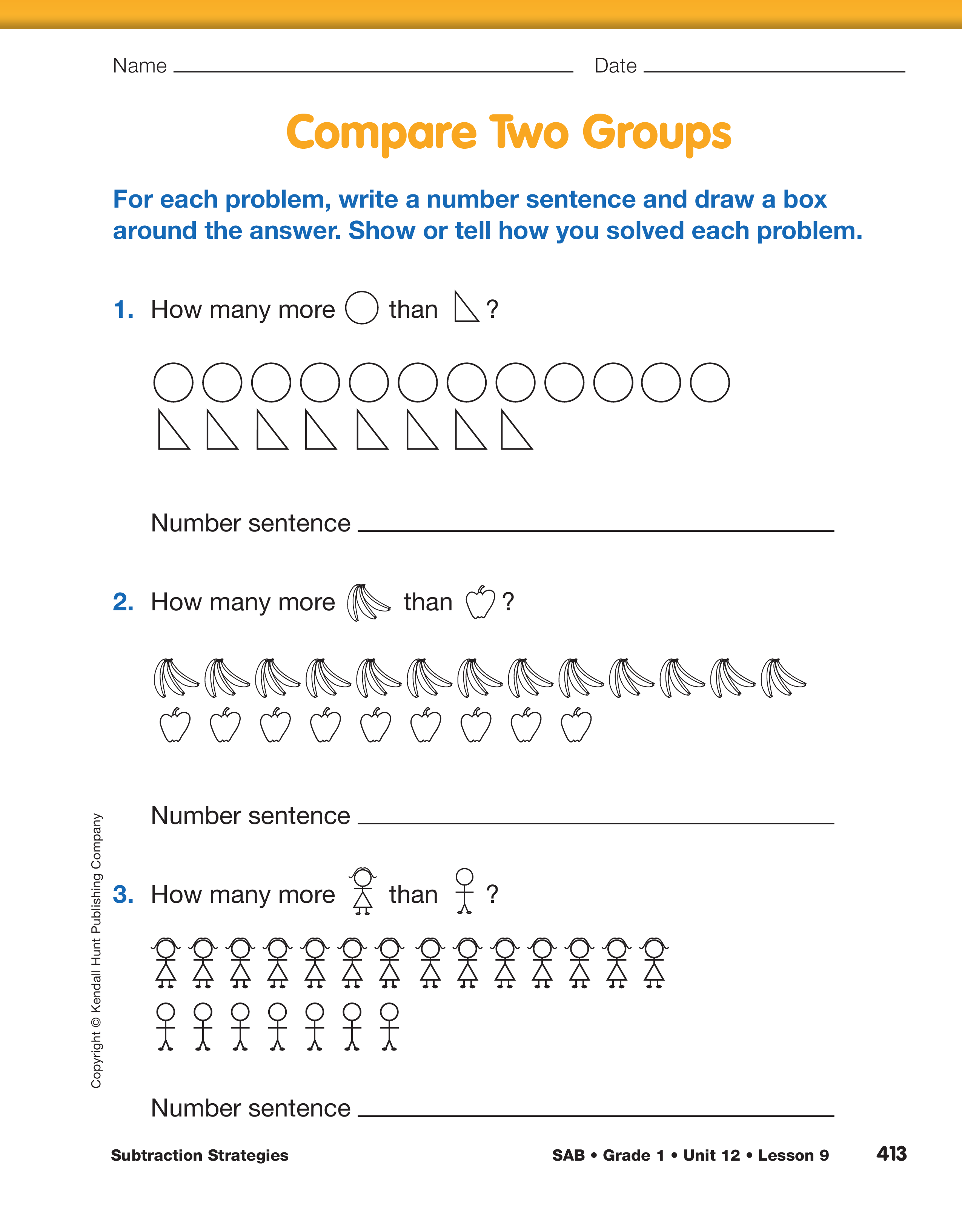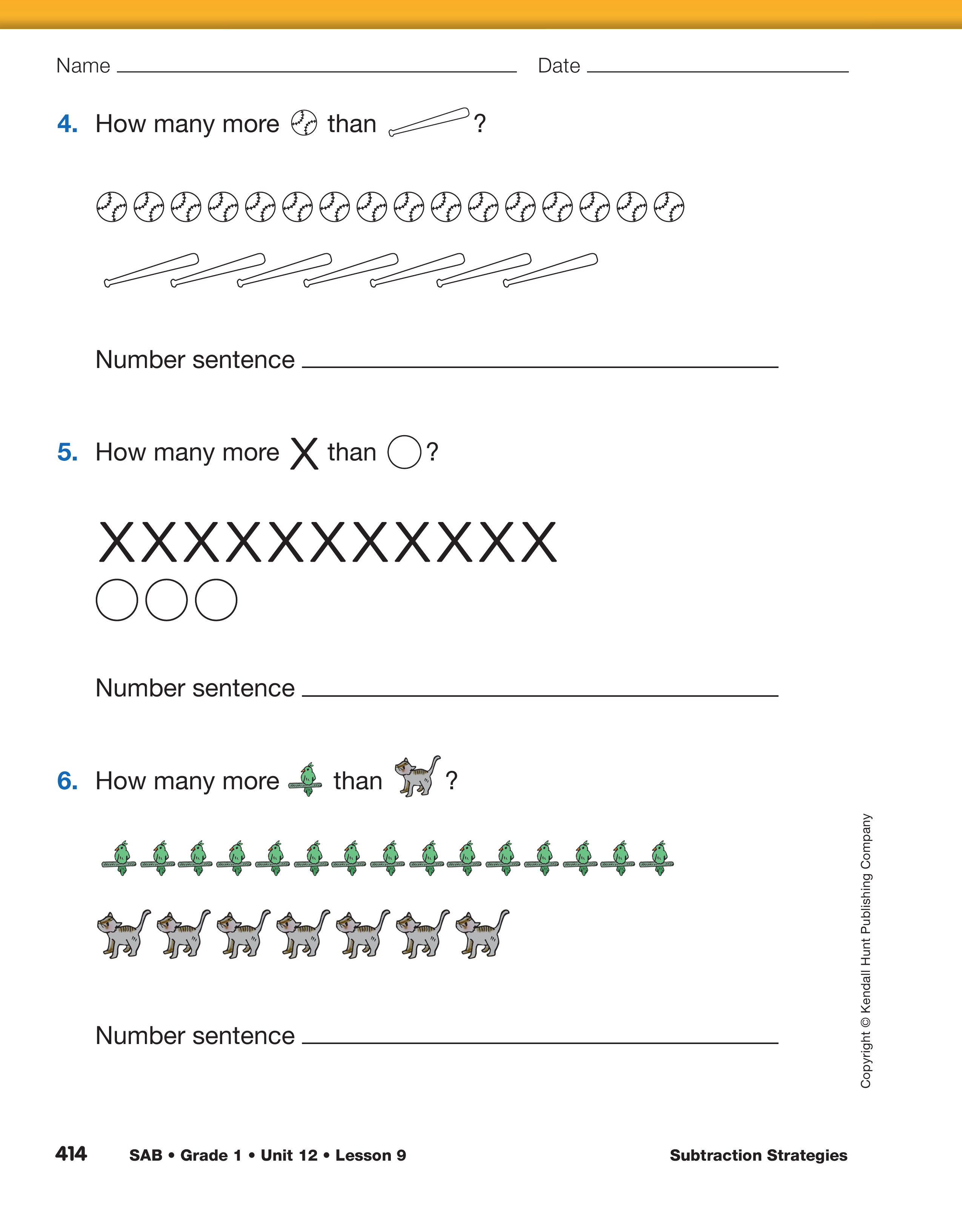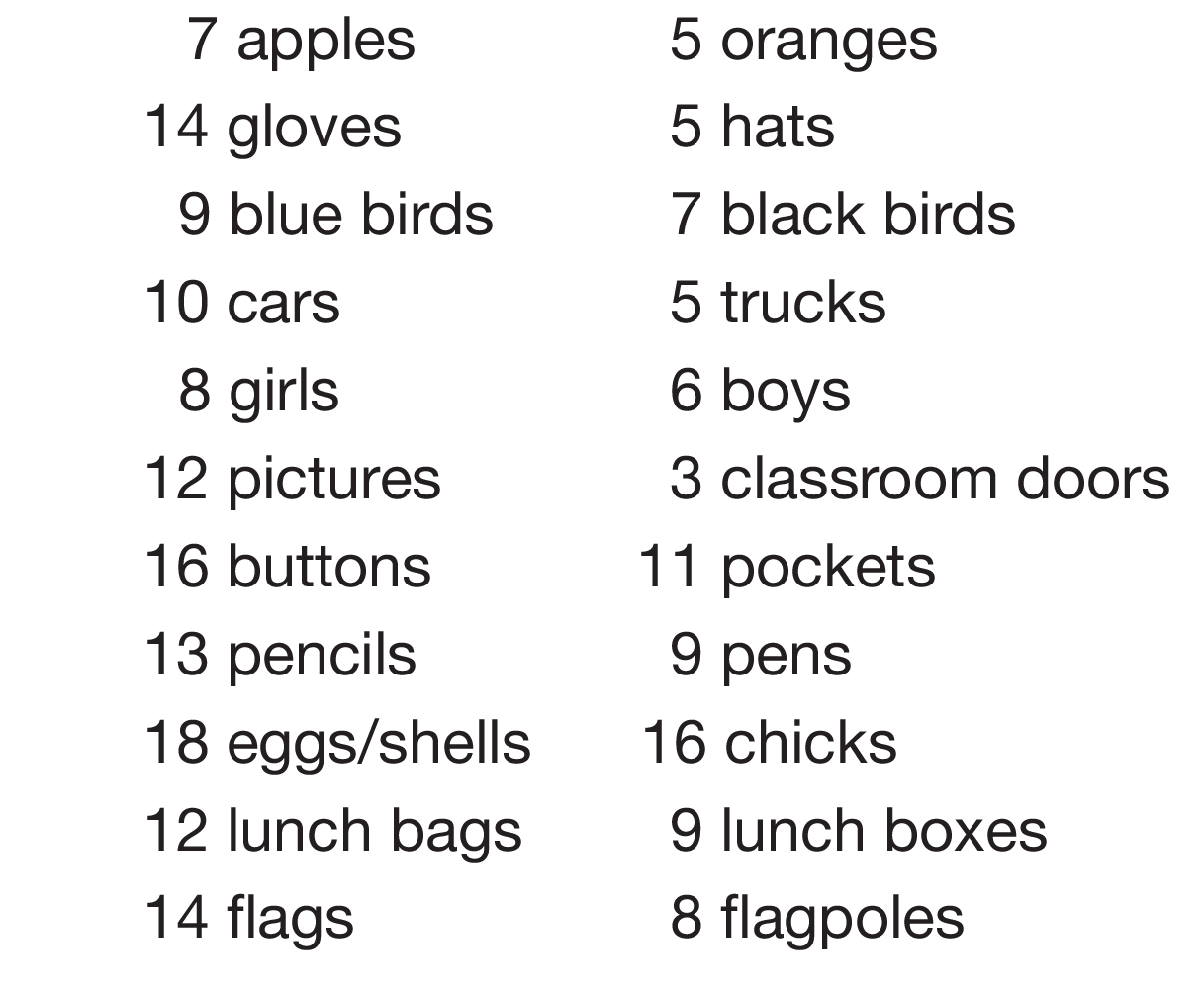Review Invented Strategies.
Display and review
the strategies on the Invented Strategies chart from
Lesson 1 of this unit. During this lesson, students
will discuss how to use the addition strategies to
solve subtraction problems and continue to add
strategies to the chart.
Solve Comparison Problems.
Use a children's literature
book or the classroom environment to generate
a list of things to compare. See Figure 1.
- How many more [girls] than [boys] are in the the class?
- How many more [children] than [adults] live in your home?
- How many more [blue crayons] are in the box than [red crayons]?
The book How Many Blue Birds Flew Away?: A Counting
Book with a Difference by Paul Giganti, Jr. was used to
generate the list in Figure 1. You may use similar counting
books to generate a list as well. If a book is not available,
simply count and list things that can be compared in the
classroom.
Then, give each student pair 2 groups from the list (e.g., 7 apples and 5 oranges) and have them draw each group on a large sheet of paper.
Students should include the following questions on their drawing:
- How many [apples] did you count? (7)
- How many [oranges] did you count? (5)
- How many more [apples] than [oranges] are there in the picture? (2)
- What is your number sentence? (7 − 5 = or 5 + = 7)
Upon completion, have students show the class their pictures, demonstrate their number sentence, and explain their strategy for solving the problem.
- What strategy did you use to solve the problem? (Possible response: I used counting on. I put 5 in my head and counted on: 6, 7. The answer is 2.)
- How can we use cubes to model the problem? (Make a train of 7 cubes and a train of 5 cubes. Place the two trains side by side and compare the two. The 7-cube train has 2 more.)
After students complete their drawings, compile the pictures
into a book or place them on a bulletin board display with the
title: How Many More and place it in a learning center. Have
students make other problems similar to the ones they
created for their class book.
Continue asking the above questions for each comparison
situation. Take note of the strategies students
use.
- Is that strategy efficient for this problem?
- Is there another way to solve the problem?
Encourage students to use other strategies and tools
(e.g., using 10, doubles, making 10, counting back
using the number line, using related facts or fact
families) to solve the problems. See Figure 2 for
several possible solution strategies to comparison
situations presented in the book.
For example, when comparing the number of flags to flagpoles (14 − 8) ask:
- What strategy could you use to find out how many
more flags there are than flagpoles? (Possible response: Counting up; I think 8 flagpoles in my
head and count up using my fingers: 9, 10, 11,
12, 13, 14. The answer is 6.)
- Solve the problem another way. (Possible response: I use fact families. I know 8 + 6 = 14, so 14 − 8 = 6.)
- Is there another way to solve 14 − 8? (Possible response: You can use doubles in your head. I know
7 + 7 = 14, so 14 − 7 = 7. 14 � 8 takes one more off, so the answer is 6.)
- Let's compare the strategies we used. Which one is more efficient? (Answers will vary.)
- Which is not very efficient? Why? (Possible response: Counting up. It takes longer and I have to use my fingers.)
If students suggest strategies that are not on the
chart, add them and discuss how to use the new
strategies to solve subtraction problems.
Use Addition or Subtraction to Find Differences.
Point out that when students
solve comparison problems, they can use subtraction
or addition. Explain that the answer in a subtraction
problem is called the difference. Some students will
use the strategies of counting on, counting back, or
related addition and subtraction facts to find the difference
but will have difficulty explaining which
number in the number sentence tells how many
more. Give several examples of using addition number
sentences to find the unknown number so that
they understand which number is the answer.
- If I use addition to solve the problem of comparing
7 apples and 5 oranges, how could I write the number
sentence? (5 + = 7)
- Is it possible to turn around the numbers in an
addition problem and still get the same answer? (Yes, you can write 5 + = 7 or + 5 = 7.)
- If my number sentence is 5 + 2 = 7, which number
tells how many more apples than oranges? (2)
- How do you know? What do the numbers in the
number sentence stand for? (The 5 shows how many oranges there are. The 7 shows how many apples there are. We have to add 2 more oranges to make the same number of apples.)
Tell students that when writing number sentences,
they should draw a box around the number that tells
how many more so that it is clear which number is
the answer.
- If I use subtraction to solve the problem, how could I write the number sentence? (7 − 5 = )
- Is it possible to turn around the numbers in a subtraction problem and still get the same answer? (No, you have to write the larger number first.)
- If my number sentence is 5 + 2 = 7, which number
tells how many more apples than oranges? (2)
- If my number sentence is 7 − 5 = 2, which number tells how many more apples than oranges? (2)
Use Strategies to Solve Comparison Problems.
Use a display of the Compare Two Groups pages in
the Student Activity Book to introduce the activity.
Students may remember a similar activity from
Unit 6 where they compared two sets with smaller
sums. For this activity, they will compare sets with
sums to 20.
Have student pairs solve the problems on the
Compare Two Groups pages. Each student can solve
the problem using his or her own strategy and then
compare answers. Display the Invented Strategies
chart so that students can refer to it during the lesson.
Have number lines, ten frames, connecting
cubes, and 100 Charts readily available.
When students are finished, discuss the various
strategies students used to solve the comparison
problems. See Sample Dialog for a discussion about
strategies.

Use this Sample Dialog to discuss student strategies for solving Question 1 on the Compare Two Groups pages.
Teacher: What are some of the strategies you used to solve
Question 1?
Mariella: I used counting back. I found 12 on the number line
and counting back 8, I landed on 4.
Teacher: That's correct, Mariella. What is your number
sentence?
Mariella: I wrote 12 − 8 = 4.
Teacher: Very good. Did someone find a way to solve it in
a different way?
Nick: I started at 8 and counted up to 12 and got 4. I think
my way is faster.
Teacher: What is your number sentence?
Nick: Since I started at 8 and counted up to 12, I said
8 + = 12. When I found the answer, I put 4 in the
box.
Teacher: Good thinking, Nick. For this problem, Nick said
it's faster to use counting up instead of counting back.
We want to use efficient strategies to solve problems.
When is it a good idea to use counting back?
Javier: I think when you don't have to count back very much.
I wouldn't want to start at 50 and count back 23.
Teacher: Good answer, Javier. It's efficient to use counting
back when you have to subtract small numbers, such
as 1, 2, or 3. You also want to use that strategy when
you count up small numbers. What else did you use to
solve the first problem?
Faith: I used fact families. I know that 8 + 4 = 12, so I know
the answer for 12 − 8 is 4.
Teacher: That's a wonderful strategy! Faith solved the
problem in an efficient way because she already
knows her addition facts and she used the related
addition fact to solve the subtraction problem. Did
anyone use a mental math strategy like making 10 or
using 10?
Eric: I used making 10. I know that 8 + 2 = 10 and 12 is 2
more than 10, so I added 2 more to 2 and I got 4.
Teacher: We have some great strategies! Let's add the
ones we don't have to our Invented Strategies chart.


















